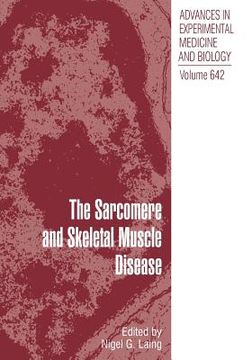Reseña del libro "the sarcomere and skeletal muscle disease (en Inglés)"
The gene, and its protein product, in a serious inherited muscle disease was first identified in the case of Duchenne muscular dystrophy some twenty years ago. Dystrophin turned out to be a sarcolemmal protein. This was somewhat of a surprise because many had harboured the view up until then that most muscle diseases, if not all, might be due to defects in the sarcomere itself. After all this was the site of muscle contraction. However many other muscular dystrophies have subsequently been shown to be due to defects in various other sarcolemma-associated proteins.1 The structure of the sarcomere itself has been studied and known for many years.2 But only in more recent times has the role of its structural and contractile proteins been detailed in specific muscle diseases. The cytoskeleton is held together by filamentous proteins, such as a-actinin and desmin, and the microtubular protein tubulin. Other proteins are nebulin and telethonin and the elastic element titin. Finally there are the contractile proteins troponin, tropomyosin, actin and myosin. Here experts in the field describe a variety of diseases associated with defects in these sarcomeric proteins often first suspected because of a pronounced accumulation of the relevant protein in the muscle tissue. Recently a few, relatively rare dystrophies themselves have also been shown to be associated with defects in sarcomeric proteins, for example, myotilin in LGMD1A, telethonin in LGMD2G, and titin in LGMD2J. The latter is of particular interest in the present context. Whereas homozygous mutation of the titin gene result in the autosomal recessive, severe, early onset 2J form of limb-girdle muscular dystrophy, heterozygosity for the same and other dominant mutations results in a mild, late onset form of distal (tibial) myopathy.3,4 Furthermore myotilin mutations have now been demonstrated in myofibrillar myopathy, or desmin-related myopathy, as well as in LGMD1A.5 These observations and several other examples in the text raise fundamental questions: how do we explain the very different clinical phenotypes which can result from different mutations in the same gene, and occasionally in different members of the same family with the same mutation? This problem is not unique to the sarcomeric diseases. It is also well exemplified in the case of mutations of the LMNA gene resulting in multiple laminopathies, defects in nuclear membrane proteins, a problem which has been recognised for some time.6 Further detailed analysis of specific mutations in these disorders may provide some answers. But it is also possible that studying associations with single nucleotide polymorphisms or copy number variants7-10 may be helpful though so far most of this research has centred more on commoner multifactorial conditions. These seem to be unexplored territories in regard to genetic forms of muscle disease. Furthermore acute quadriplegic myopathy, due to a preferential loss of myosin and myosin-associated thick filament proteins, is acquired and not genetic. It is also perhaps possible that certain common pathogens could affect disease presentation via their interaction with, for example, actin filaments and the induced filament rearrangements.11 But again this is a field which has so far not been explored. The results of the studies presented in this volume now pave the way for much future research into the pathogenesis of this group of fascinating conditions, leading one day to their treatment. References: 1. Winder SJ, ed. Molecular Mechanisms of Muscular Dystrophies. Austin: Landes Bioscience, 2006. 2. Hanson J, Huxley HE. Structural basis of cross striations in muscle. Nature 1953; 172:530-533. 3. Udd B, Käärianen H, Somer H. Muscular dystrophy with separate clinical phenotypes in a large family. Muscle Nerve 1991; 14:1050-1058. 4. Hackman P, Vihola A, Haravuori H et al. Tibial muscular dystrophy is a titinopathy caused by mutations in TT N, the gene encoding the giant skeletal-muscle protein titin. Am J Hum Genet 2002; 71:492-500. 5. Selcen D, Engel AG. Mutations in myotilin cause myofibrillar myopathy. Neurology 2004; 62:1363-1371. 6. Emery AEH. The muscular dystrophies. Lancet 2002; 359:687-695 (see OMIM 150330). 7. Christensen K, Murray JC . What genome-wide association studies can do for medicine. New Engl J Med 2007; 356:1094-1097. 8. Redon R, Ishikawa S, Fitch KR et al. Global variation in copy number in the human genome. Nature 2006; 444:444-454. 9. Lock DP, Sharp AJ, McCarroll SA et al. Linkage disequilibrium and heritability of copy-number polymorphisms within duplicated regions of the human genome. Am J Hum Genet 2006; 79:275-290. 10. Stranger BE, Forrest MS, Dunning M et al. Relative impact of nucleotide and copy number variation on gene expression phenotypes. Science 2007; 315:848-853. 11. Rottner K, Lommel S, Wehland J, Stradal TEB. Pathogen-induced actin filament rearrangement in infectious diseases. J Pathol 2004; 204:396-406.

